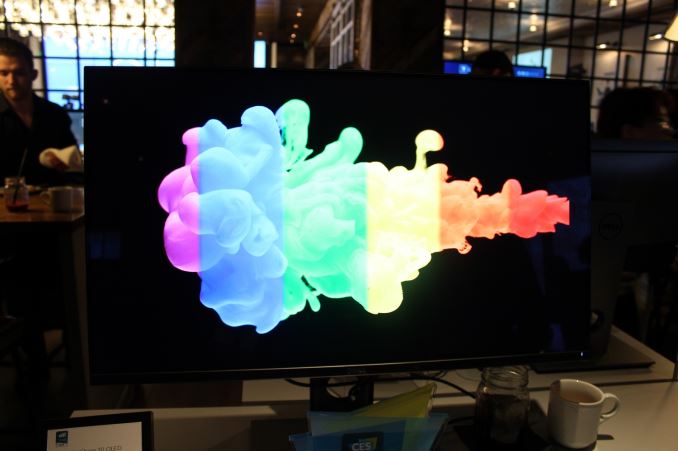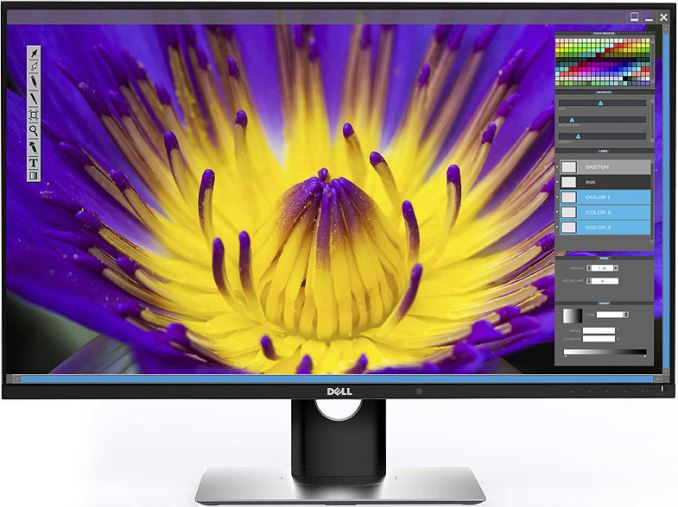Dell Demonstrates 30-inch 4K OLED Display
by Anton Shilov on January 7, 2016 6:40 PM EST- Posted in
- Monitors
- Dell
- Trade Shows
- 4K
- Ultrasharp
- CES 2016
- 30"
- OLED
- UP3017Q

Dell does not produce its own display panels, but when it comes to unique “world’s first” monitors, it is sometimes years ahead of all of its rivals. At the International CES 2016, Dell introduced its UltraSharp 30-inch OLED display, the company’s first monitor to use organic light emitting diode panel. The product is designed for professionals and carries a rather extreme price tag, but this is going to be a dream display for years to come.
The Dell UltraSharp UP3017Q is a 30-inch display with 3840×2160 resolution, 0.1 ms response time and an unknown refresh rate (yet, it should be very high). The monitor can reproduce 1.07 billion colors, it covers 100% of Adobe RGB color space as well as and 97.8% of DCI-P3 color space (used for digital movie projection by the U.S. movie industry and is expected to be adopted in televisions and in home cinema), according to Dell. Just a few professional displays nowadays cover 100% of Adobe RGB. The manufacturer declares 400,000:1 dynamic contrast ratio, but admits the value is only that because testing equipment won't go higher.
The UltraSharp UP3017Q ultra-high-definition display has very narrow bezels; the monitor itself is thin, but not remarkably thin like OLED TVs, possibly because it features internal power supply unit as well as complex logic inside. The monitor features a mini DisplayPort (mDP) connector, an HDMI port as well as a USB type-C port, which could be used for video and data connectivity as well as for power delivery (it can be powered using a type-C cable, or deliver power to another device).
Emissive electroluminescent layer in organic light-emitting diode is made of organic compound that emits light in response to an electric current. The organic semiconductor layer is situated between two electrodes and does not require a backlight. As a result, it can display truly deep black levels, unlike liquid crystal display (LCD) panels, which use various kinds of backlighting. Besides, since the emissive electroluminescent layer is very thin and can take different shapes, it is possible to build ultra-thin and even curved monitors and TVs using OLEDs.
While OLED technology can deliver deep blacks, high contrast ratio and exceptional colours, it is not free of drawbacks. The organic layer may burn down over prolonged amount of time, and colors can shift over time. To maximize lifespan of the OLED panel inside the UltraSharp UP3017Q, Dell integrated a special presence detector into the front panel of the display, which switches the monitor off when nobody uses it. Another disadvantage of OLEDs is a possibility of static image burn in. To reduce the chance of burn in, the UP3017Q has a special pixel-shifting technology.
The Dell UltraSharp 30 OLED monitor will cost whopping $4,999, which it becomes available on March 31, 2016, in the United States. The display at this point is only aimed at professionals, who work in color-critical environments such as graphic arts and photography. However, due to exceptional colors and contrast as well as ultra-fast response time, the UltraSharp UP3017Q will be a dream display for gamers, prosumers and other users, who value quality.
OLED panels are considerably more expensive to produce than modern LCD panels, partly because of lower yields. Last year an executive from LG Electronics said that yields of OLED panels had reached 80% and would continue to grow. At the International CES 2016, Kwon Bong-suk, the head of LG’s TV business, said that the company had cut prices of OLED TVs in the U.S. by 45% late in 2015. As a result, LG now expects sales of OLED televisions to triple this year. Price reduction of OLED TVs indicates that production costs of organic light-emitting diode panels are going down. Perhaps, over time, the Dell UltraSharp UP3017Q will also become more affordable, or Dell will release an OLED display for a wider audience.











83 Comments
View All Comments
RaistlinZ - Friday, January 8, 2016 - link
Do want.Tobarus - Saturday, January 9, 2016 - link
I, for one will definite be buying this. The only thing that comes close is Ezio's true 4K display (not UHD) and that costs even more! Yes, OLED does have some serious draw backs, but the specs alone far and away blow any "competition" out of the exosphere. This monitor will most definitely not be sitting in a dorm room somewhere (the only "clientele" complaining).The only drawback I see in this monitor for myself is the timing, as in the exact same time frame I bought the Nikon D5! As for all the other "drawbacks", simple preventative measures in place will ensure years of use from this.
Finally, a company is stepping up to the plate and taking a risk by offering something truly innovative and game changing. I don't think I'll miss my NEC, even though this new monitor is double the price. A bit of a cliche, but reminds me of when the first iPhone came out.
Well done Dell (and LG)!
Sivar - Monday, January 11, 2016 - link
Other disadvantages of OLED vs LCD:- OLED typically cannot reach the brightness levels of an LCD screen, and the higher OLED's brightness setting, the more quickly they degrade.
- OLED's colors deteriorate at different rates. Blue typically deteriorates at roughly 3x faster than green, with red somewhere in the middle. This can be somewhat mitigated with software that increases each color's intensity relative to its expected decay rate, but the increase brightness will only kill the display faster.
I suspect some companies will experiment with having 2 blue pixels for each red/green, though this can have its own problems.
Still, these problems will be resolved like any other and OLEDs will likely, finally overtake LCD screens as the display of choice. Their fantastic contrast ratio and color accuracy are far ahead of anything LCDs can do even in the most experimental of lab settings.